Asesmen Nilai-Nilai Pariwisata Terhadap Fitur Geologi Daerah Bongo dan Sekitarnya Sebagai Dasar Pengembangan Geowisata di Pesisir Selatan Gorontalo
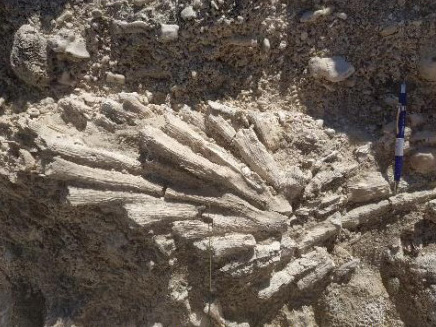
Coral limestone.
Geology is an important aspect in the development of tourism in an area. One of the attractions in a natural tourism location is certainly highly controlled by the geological setting in the area. The purpose of this research is to assess tourism values of geological features in the Bongo and surrounding areas as a basis for developing geotourism on the southern coast of Gorontalo. The research location is at coordinates N 00029’42” - N 00029’51” and E 12301’26” - E 12303’32”. The method used in this study is a surface geological survey, which includes field data collection in the form of lithology, geological structure and geomorphology. The standard used for assessing tourism values is the technical guide for assessing geological heritage resources by the Geological Survey Center. The results showed that the lithology unit of the study area consists of granite, volcanic breccia and reef limestone. The geological structure in the research area is shear fracture with main stress that relatively directed to northwest-southeast. The geomorphic unit of the study area consisted of two units, namely volcanic hills, and marine units. The results of the assessment of tourism values on geological features explain that the Bongo and surrounding areas are included in the medium category. Improvements are needed on low value criteria, namely vulnerability, relationships with other values, and economic level.
Keywords: Geotourism, Geological feature, Tourism assessment.
Septian, Y., Ndangi, W., Manyoe, I.N, Taslim, I., Umar, E., Salama, T., & Napu, S. (2019). Asesmen Nilai-Nilai Pariwisata Terhadap Fitur Geologi Daerah Bongo dan Sekitarnya Sebagai Dasar Pengembangan Geowisata di Pesisir Selatan Gorontalo. Jurnal Azimut, 2(2), 146-154.
Efficiency and energy modelling for PVT air collector with extended heat transfer area: a review
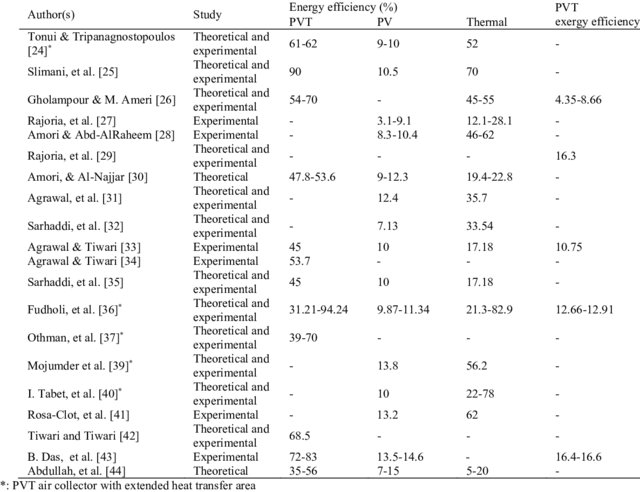
Studies conducted on PVT air collectors.
Solar energy is renewable and environment friendly and has been widely used in electricity generation and thermal energy through photovoltaic thermal (PVT) system. This system is beneficial in terms of maximum energy generation and cost of usage. The growing concern on energy sources and their usage has increased the significance and demand for PVT collectors. A PVT air collector consists of a PV panel and a thermal collector system. In PVT air collector, electricity and thermal energy are generated simultaneously. This review focuses on efficiency and energy modelling for PVT air collector with extended heat transfer area. Findings of this review indicated that PVT air collector with extended heat transfer area produced PVT efficiency higher than conventional PVT air collector. The thermal efficiency of PVT air collector for with and without extended heat transfer area are 21-83% and 12-70%, respectively, which the improvement of thermal efficiency is 15.7-42.8%.
Keywords: Renewable energy, Thermal modelling, Photovoltaic, Thermal, Solar collector.
Fudholi, A., Musthafa, M. F., Taslim, I., Indrianti, M. A., Manyoe, I. N., & Othman, M. Y. (2019). Efficiency and energy modelling for PVT air collector with extended heat transfer area: a review. Int J Pow Elec & Dri Syst Vol, 10(4), 2029-2036.
Peningkatan Pengetahuan Gempa Dan Kemampuan Mitigasi Pada Siswa Disabilitas Kota Gorontalo Melalui Program Mie Titi
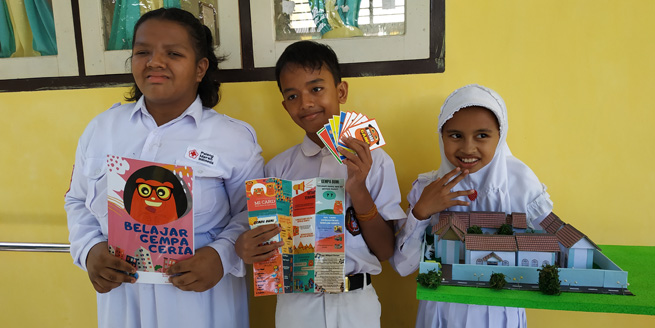
Disability students and MIE TITI media.
The condition of Gorontalo City has a high level of vulnerability to earthquake hazards, therefore understanding of earthquakes needs to be done early on, especially for children with disabilities. MIE TITI aims to increase earthquake mitigation knowledge and ability for students with disabilities at SDLB Gorontalo City, especially the visually impaired, deaf, and mentally disabled. The method to be used is a fun learning method with instruments used in the form of MINING (Music Fun Learning), MICARD (Mitigation Flascard), MINAME (Mitigation of Nature Game) and Oil and Gas (Mitigation Praise). A sample of 34 people with disabilities in Gorontalo City SDLB consisted of blind, deaf and retarded students. The results obtained are an increase in earthquake knowledge and earthquake mitigation ability in students with disabilities where in children with visual impairment by 50% and 35%, deaf by 45% and 55%, and mental retardation by 3% and 2%.
Keywords : Mitigation, Earthquake, Fun Learning, Disability, Gorontalo.
Duwingik, R. F., Della Nawarita, P. K., Dano, M. A., & Manyoe, I. N. (2019). Peningkatan Pengetahuan Gempa Dan Kemampuan Mitigasi Pada Siswa Disabilitas Kota Gorontalo Melalui Program Mie Titi. Warta Pengabdian, 13(3), 116-122.
Kajian Mitigasi Bencana Tanah Longsor Ruas Jalan Meluhu-Lasolo, Sulawesi Tenggara
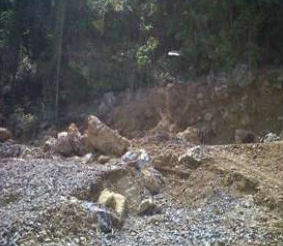
Limestone outcrop (Umar, 2019).
Geological hazards at Meluhu-Lasolo North Konawe are much more destructive when prevail can cause greater damage to lives and properties of humans when not properly and timely controlled and mitigated. This study aims to do an inventory of the types of disasters and determine all the locations that disaster-prone at Meluhu-Lasolo North Konawe Regency. The research method that will be used is an inductive method with approach combination between qualitative research and quantitative research, integrate all the literature review's results, field data, and all the results from laboratory computation research which have been reviewed, analyzed, and synthesized comprehensively. The result of this research is there is 2 (two) points of prone locations and the type of disaster is a landslide in the form of debris slide and rockfall, it is including as a high category of disaster-prone (score 4) with slope ranges from 29-850. The cause of that landslide is because that area has a steep slope, high rock weathering, cracked rock and easy to fall off, including fault line, slope that cut off by the road and vibration from all the high load vehicle that passing by, make the drainage channel defective and threatening human lives or the vehicle that passing by. There are a few things that have to do independently by the people who live there is to be more alert when rainy season come and fix all the road that have been cracked, and soil conservation.
Keywords : geology; landslide; Meluhu-Lasolo; mitigation.
Umar, E. P., Jamaluddin, J., Mustafa, M., Marnas, M. A., Manyoe, I. N., Nurfalaq, A., & Taslim, I. (2019). Kajian Mitigasi Bencana Tanah Longsor Ruas Jalan Meluhu-Lasolo, Sulawesi Tenggara. Jurnal Geocelebes, 3(2), 51-58.
Geologi dan Manifestasi Thermal Libungo
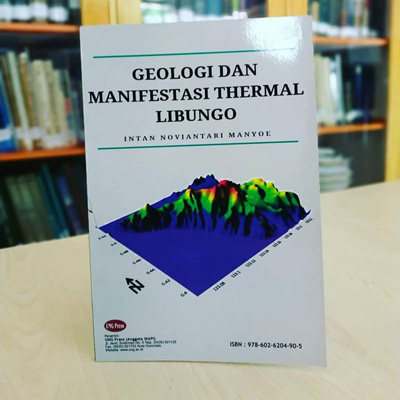
Buku Geologi dan Manifestasi Thermal Libungo.
Geotermal atau panas bumi adalah salah satu sumber energi terbarukan yang potensinya melimpah di Indonesia. Pemerintah Indonesia melalui Badan Geologi terus mendata dan meneliti potensi geotermal di seluruh wilayah Indonesia. Penelitian terhadap potensi geotermal juga dilakukan oleh para peneliti di perguruan tinggi. Buku ini membahas kondisi geologi dan manifestasi termal di daerah Libungo, Kabupaten Bone Bolango. Pembahasan difokuskan pada manifestasi termal, stratigrafi, struktur geologi, geomorfologi dan hidrogeologi daerah Libungo.
Manyoe, IN. (2019). Geologi dan Manifestasi Thermal Libungo. UNG Press, Gorontalo.
